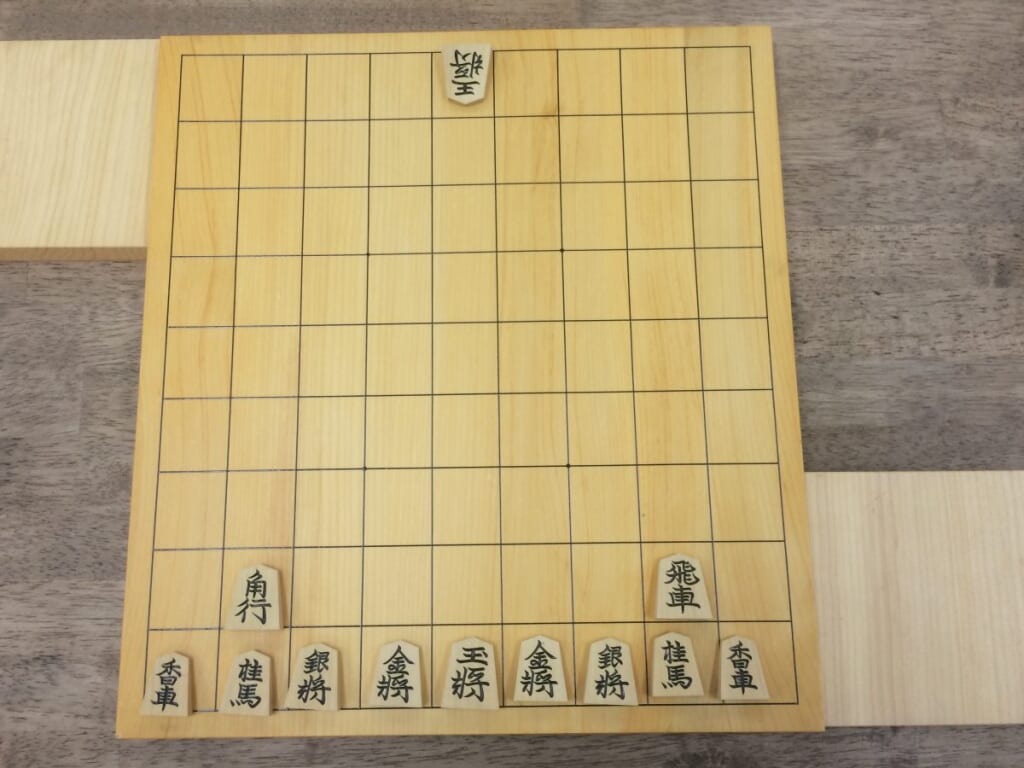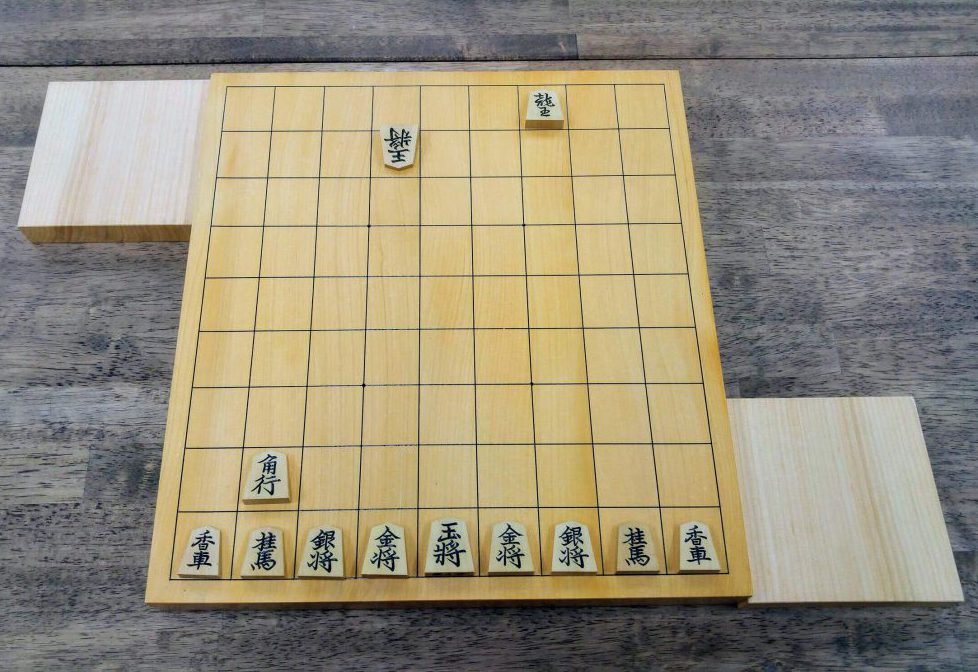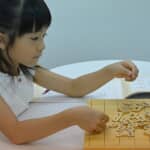Shogi 10 April 2019
Bible of Handicap Game –10 Pieces Dropped, without Fu (Pawn)–
A handicap game in Shogi is called Koma Ochi in Japanese. Either stronger player drops his/her own piece/pieces. The number of dropped pieces depends on the difference in skills. The bigger the difference is, the more pieces a player drop. Originally, Koma Ochi was introduced to make a game more fun eliminating the skills gap. Learning Koma ochi is also very effective to understand Shogi.
Especially, it’s challenging for Shogi beginners to play Hirate, an even game, because there are too many pieces to pay attention to all. Meanwhile, when they play Koma Ochi, an opponent has dropped pieces, and this allows beginners to determine what weak points are or where their attacks work well.
When I teach a lesson in a Koma Ochi situation, I put weight on learning a key point underlies Koma Ochi, not on getting hung up on the result of a game.
In this article and the coming several articles, I will tell you a key point underlies each type of Koma Ochi, which has several types, a 10 pieces dropped type, a 9 pieces dropped type, etc. I will also set the goal you need to reach through learning Koma Ochi and explain what you are supposed to learn. The series of articles is entitled “Bible of Handicap Game”. I often compare Shogi to an adventure. You need to have a compass when you go off on adventures. I wish these articles could be your compass for Shogi.
Bible of Handicap Game: 10-piece Handicap without Fu (Pawn)
First, I am going to tell you the easiest Koma Ochi situation, a 10-piece handicap, or Ju-mai Ochi in Japanese, in which a stronger player removed 10 pieces other than Fu (Pawn). In i-tsu-tsu Shogi classes, we usually use a 10-piece handicap without Fu (Pawn) for children who has just started Shogi. I often compare this handicap to a house without a roof, saying “Look, there is no roof.” In Shogi, the roof generally comprises 10 pieces of Fu (Pawn) placed on the front line. What if a house doesn’t have a roof? It must be troublesome!
Goal to Learn a 10-piece Handicap without Fu (Pawn)
Promote Hi (Rook) and Kaku (Bishop)

10-Piece Handicap without Fu (Pawn)
What I want children to learn the most through learning a 10-piece handicap is to gain the knowledge of how to use major pieces, Hi (Rook) and Kaku (Bishop). Major pieces move a lot at a time and play a key role in the attacking situations. I do hope that children realise how helpful they are when you let them work effectively. As you know, in Shogi, pieces become to move more after their promotions. Children experience making major pieces promoted and capture Gyoku (King) with those promoted major pieces. This is the biggest goal to learn a 10-piece handicap without Fu (Pawn), the easiest 10-piece handicap.
In addition, small children can learn Kanji in the promotion situations, such as 飛 becomes 龍, or 角 becomes 馬. Each time children promote a piece, I ask them what the Kanji is.
Why 10-Piece Handicap without Fu (Pawn) ?
In the basic 10-piece handicap game, pieces of Fu (Pawn) are placed at the top of both players’ camps as their roofs. Fu (Pawn) moves very slow, one square at a time. It’s rather hard for small children to break through a train of Fu (Pawn), using pieces other than Fu (Pawn). The roof seems to prevent children from proceeding other pieces to reach an opponent’s camp to get promoted.
A practice which works well for this issue is to play a game with a 10-piece handicap without Fu (Pawn). With this handicap, there is no roof and children can freely and dynamically move pieces. Especially, it’s possible for Hi (Rook) and Kaku (Bishop) to get a promotion on the first move. Children must be tempted to use those major pieces. Getting promoted, major pieces gain new moves and become mighty pieces. Children, boys on particular, love the word “mighty”. You can tell them, “your goal is to make mighty pieces.” It can be the powerful motivation.
For your information, there is a game-type named Blue sky Shogi, Aozora Shogi in Japanese. Players play a game outside. Occasionally, they don’t use Fu (Pawn), even when they play a non-handicap game. Try out it to practice and learn how to move pieces placed under Fu (Pawn).
Build Up Skills
If you’ve got to know the way to promote Hi (Rook) and Kaku (Bishop) and have an idea of how to achieve checkmate, you could say you reached a satisfactory completion of the practices with a 10-Piece handicap without Fu (Pawn). I suppose some of you are aiming higher. For those, let’s think about how you can checkmate with a minimum number of moves.
Block Gyoku’s (King’s) Escape Routes
It makes things easier to think how to block Gyoku’s (King’s) escape routes rather than how to take Gyoku (King). It can generally apply not only to a situation in which you play a game with a 10-Piece handicap without Fu (Pawn) but also to a checkmate situation. For example, when Shogi beginner children practice a game with a 10-Piece handicap without Fu (Pawn), as their first move, they often move Hi (Rook) to the first rank, the first horizontal row, to check. It apparently looks a good move, but there is a flaw. Look at the picture below. The Hi (Rook) got a promotion at the first rank, which allows Gyoku (King) to move forward to escape. The Gyoku (King) must keep running away to the wide open space.

What to be done is that you should promote Hi (Rook) at not the first rank but the second one. In case you promote Hi (Rook) at the second rank, reaching power of the promoted Hi (Rook), Ryu (Promoted Rook), will cover the entire second rank. This means you can completely block the routes for Gyoku (King) to escape.
I will give you a tip to get children to understand this. You may use marbles or something to visualise reaching power of this Ryu (Promoted Rook), like the picture below, saying “What if your Gyoku (King) reach this rank?” It will get burned with Ryu’s (Promoted Rook’s) reaching power which is like a beam of light. I don’t know if Ryu’s (Promoted Rook’s) reaching power is actually hot enough to burn something, though.
I have one more thing to point out here. When you play a game with a handicap, the player who has dropped pieces will play first. For those who are the first players, I would recommend that you don’t move your Gyoku (King) to the second rank on your first move. Instead, move it to the right or left on the first rank, so that children can experience what happens when Hi (Rook) gets a promotion at the second rank.

Horizontal Ryu’s (Promoted Rook’s) Reaching Power Blocks Upward Escape Routes
All Gyoku (King) can do now is to wander around on the first rank. Use the most use of Uma (Promoted Bishop) and close upon Gyoku (King). Let’s give some tips to children, which help them move Uma (Promoted Bishop) close to Gyoku (King). When children move Ryu (Promoted Rook) on the second rank, let Gyoku (King) escape, saying “Yay!” and moving it forward. Once Uma (Promoted Bishop) reaches the position shown below as Figure #4, take time to explain what “checkmate” is.

Figure #4
Tell children the following important point; you need two pieces to check, one to check and another to support the other. After reaching a checkmate situation, make sure three points, Gyoku (King) has none escape routes, another piece supports the piece which is checking, and there is no space to put a new piece between existing pieces. Then admit children won the game, saying “I resign.”
That’s all we are going to cover today’s topic, a 10-piece handicap without Fu (Pawn). Is everything clear?
As I told you there are several types of piece-dropping handicaps. Let’s keep practicing one type many times, controlling when and how often you give advice. You may grasp children’s progress of understanding.
In this article, I recommended that you move your Gyoku (King) only to the right or left as your first move. After a while, when you find children’s progress, you may move it to the second rank. Some children who have got the hang of it could apply the foundation of these practices and make Hi (Rook) promoted on the third rank.
There might be some children who want to use pieces other than Hi (Rook) and Kaku (Bishop) such as Kei (Knight) whose move is unique and children’s favorite. From instructors’ point of view, promoting Hi (Rook) to Ryu (Promoted Rook) and Kaku (Bishop) to Uma (Promoted Bishop) and using them are good enough and more effective to make the shortcut to the goal. Even so, please bite your tongues and wait until children get satisfied. Practice makes perfect, as you know!
Let’s review the points of a 10-Piece handicap without Fu (Pawn):
1. Promote Hi (Rook) and Kaku (Bishop)
2. Understand what Ryu’s (Promoted Rook’s) reaching power looks like
3. Learn how to checkmate
4. Capture Gyoku (King) with a minimum number of moves.
If you master all of them, surely, you won’t have any troubles!
We will discuss about a 10-piece handicap as the next topic of “The Bible of Handicap Game”.

